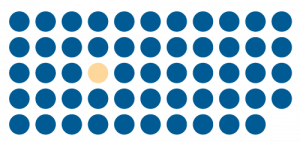Section 1: Information on Autism Spectrum Disorder (ASD)
7 ASD and Other Disorders
 According to the most recent figures released through the Centers for Disease Control and Prevention (CDC) in 2020, one in 54 individuals has a diagnosis or meets the criteria for ASD. It affects people of all races, ethnicities, social classes, lifestyles, and educational backgrounds equally; however, ASD is approximately 4 times more likely to occur in boys than in girls. Approximately 10% of individuals with ASD have other genetic, neurological or metabolic disorders such as fragile X syndrome, tuberous sclerosis, Down syndrome or other chromosomal disorders.
According to the most recent figures released through the Centers for Disease Control and Prevention (CDC) in 2020, one in 54 individuals has a diagnosis or meets the criteria for ASD. It affects people of all races, ethnicities, social classes, lifestyles, and educational backgrounds equally; however, ASD is approximately 4 times more likely to occur in boys than in girls. Approximately 10% of individuals with ASD have other genetic, neurological or metabolic disorders such as fragile X syndrome, tuberous sclerosis, Down syndrome or other chromosomal disorders.
The difference between ASD and the other common disorders mistaken for ASD relates to the etiology and/or level of challenge that is present. For example, an individual with ADHD may have social difficulties due to impulsivity or hyperactivity rather than having true social challenges. Whereas, an individual with ASD may appear inattentive and impulsive yet show ability to be appropriately attentive to areas of interest. In this case, the individual’s inability to attend to prescribed tasks may be more due to the lack of social awareness as to when they should focus on the task at hand rather than focusing on their area of interest. Concerning level of challenges, several symptoms and behaviors may exist that appear reminiscent of other disorders beyond ASD. However, an added diagnosis is only provided if the symptom or behavior exists over and above the level expected for ASD and as a means of further differentiating, emphasizing and/or clarifying the needs.
In addition to the common disorders noted above, there are a number of other potentially coexisting conditions including: (1) Specific and nonspecific medical diagnoses, (2) comorbid behavioral syndromes, and (3) comorbid symptoms that do not meet full diagnostic criteria for a diagnosis (Gillberg & Billstedt, 2000). Such coexisting conditions may include, but are not limited to:
- Epilepsy
- Hearing impairment
- Visual impairment
- Praeder-Willi syndrome
- Angelman syndrome
- Thalidomide syndrome
- Fetal alcohol syndrome
- Rubella embryopathy
- Metabolic disorders
- Developmental coordination disorder (DCD)
- Tourette’s syndrome
- Catatonia movement disorder
- Depression
- Eating disorders (e.g., anorexia nervosa, pica)
- Abnormal responses to sensory stimuli
- Abnormal sleep patterns
- Aggression
- Self-injury
(Gillberg & Billstedt, 2000; Tidmarsh & Volkmar, 2003).
ASD & Comorbidity
Some of the common disorders that can be mistaken for ASD:
- Mental retardation
- Obsessive-compulsive disorder
- Reactive attachment disorder
- Social phobia
- Language disorders
- Selective mutism
- Stereotypic movement disorder
- Schizophrenia
- Attention-deficit / hyperactivity disorder
- Personality disorder
